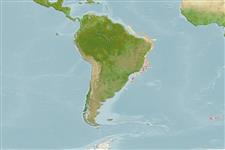Classification / Names
Common names | Synonyms | Catalog of Fishes (gen., sp.) | ITIS | CoL | WoRMS | Cloffa
Elasmobranchii (sharks and rays) >
Rajiformes (Skates and rays) >
Rajidae (Skates)
Etymology: Malacoraja: Greek, malakos = soft + Latin, raja, -ae = ray, fis (Raja sp.) (Ref. 45335); obscura: Specific name derived from the Latin obscurus, meaning dark or indistinct, in reference to the the subtle nature of the differences separating this species from its congeners.
Environment / Climate / Range
Ecology
Marine; bathydemersal; depth range 808 - 1105 m (Ref. 72455). Tropical, preferred ?
Distribution
Countries | FAO areas | Ecosystems | Occurrences | Point map | Introductions | Faunafri
Western Atlantic: continental slope of southeastern Brazil, off the states of Espirito Santo (19°39' S, 38°38' W) and Rio de Janeiro (21°46' S, 39°53' W).
Size / Weight / Age
Maturity: Lm ? range ? - ? cm
Max length : 68.0 cm TL male/unsexed; (Ref. 72455)
Life cycle and mating behavior
Maturity | Reproduction | Spawning | Eggs | Fecundity | Larvae
de Carvalho, M.R., U.L. Gomes and O.B.F. Gadig, 2005. Description of a new species of skate of the genus Malacoraja Stehmann, 1970: the first species from the southwestern Atlantic Ocean, with notes on generic monophyly and composition (Chondrichthyes: Rajidae). Neotrop. Ichthyol. 3(2):239-258. (Ref. 72455)
IUCN Red List Status (Ref. 115185)
CITES (Ref. 94142)
Not Evaluated
Threat to humans
Harmless
Human uses
More information
CountriesFAO areasEcosystemsOccurrencesIntroductionsStocksEcologyDietFood itemsFood consumptionRation
Common namesSynonymsMetabolismPredatorsEcotoxicologyReproductionMaturitySpawningFecundityEggsEgg development
Age/Size
Growth
Length-weight
Length-length
Length-frequencies
Morphometrics
Morphology
Larvae
Larval dynamics
Recruitment
Abundance
ReferencesAquacultureAquaculture profileStrainsGeneticsAllele frequenciesHeritabilityDiseasesProcessingMass conversion
Tools
Special reports
Download XML
Internet sources
Estimates of some properties based on models
Phylogenetic diversity index (Ref.
82805): PD
50 = 0.5625 [Uniqueness, from 0.5 = low to 2.0 = high].
Bayesian length-weight: a=0.00309 (0.00140 - 0.00684), b=3.20 (3.02 - 3.38), in cm Total Length, based on LWR estimates for this (Sub)family-body shape (Ref.
93245).
Trophic Level (Ref.
69278): 3.5 ±0.4 se; Based on size and trophs of closest relatives
Resilience (Ref.
69278): Medium, minimum population doubling time 1.4 - 4.4 years (Preliminary K or Fecundity.).
Vulnerability (Ref.
59153): Moderate vulnerability (43 of 100) .
